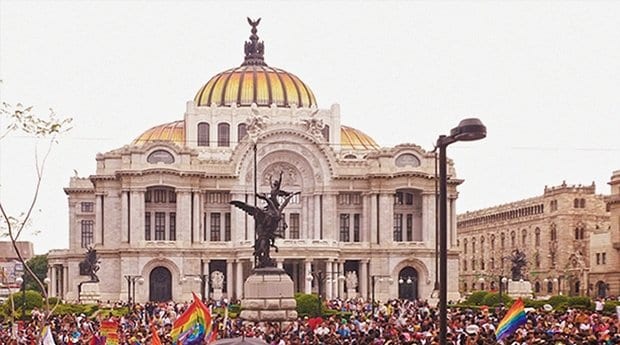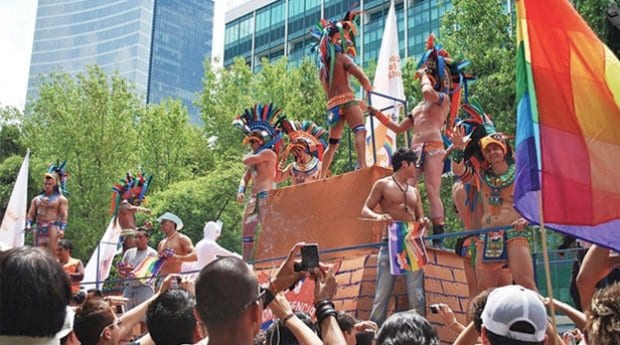
Pride revellers celebrate outside Palacio de Bellas Artes. Credit: Keph Senett
For such a major metropolis, Mexico City is often overlooked during Pride season, but this capital is not only big and bustling — it’s also actively welcoming to LGBT people. The city’s very first Pride march took place in 1979, and 30 years later the Legislative Assembly legalized same-sex marriage. And, to make things easier for out-of-towners to visit, the Mexico City tourism board recently commissioned an LGBT guide, downloadable as a PDF from its website. So if you’re considering a trip to Mexico City (also referred to as “el DF,” for Distrito Federal), consider a pilgrimage for Pride.
The very first thing you’ll notice in planning your Pride week is that the communications — posters, websites and guides — are not nearly as coordinated as you’re probably used to, and your planning will be further complicated by the fact that everything is in Spanish. Take a deep breath. Despite being a city of nearly nine million people (that number jumps to more than 24 million if you account for the greater metropolitan area), el DF is, in some ways, still emerging. The sooner you sync up with the city, the better time you’ll have.
There are two main ways to find out what’s happening: track down a Pride guide or simply ask someone. Trust me: the latter is much more fun, but if you’re too shy, get yourself into the Zona Rosa to check out lesbian bookstore Voces en Tinta or Erotika Love Store and ask for a guide (guía, in Spanish). On the web, your best bet is to locate groups and events pages on Facebook, which often are updated with more frequency than the official Mexico City Pride page. If you’re looking for the bear scene, you have your own portal at bearmex.com.
Although there are parties and events leading up to and after the parade, the main attraction happens on Pride Saturday under the banner Marcha del Orgullo y Dignidad LGBTTTI (Pride and Dignity March). You’re probably familiar with the many variations on LGBT; in Mexico City, the letters refer to lésbico, gay, bisexual, transexual, travesti, transgénero and intersexual. Don’t get too hung up on the semantics — this is an inclusive celebration, and everyone is welcome.
La Marcha begins at noon(ish), with people gathering at the base of El Ángel de la Independencia, the city’s most famous monument and the symbol of the Mexico City. If your experience of Pride is limited to recent years in the big cities (like New York, San Francisco or Toronto), one of the first things you’ll likely notice is that, despite its size (2013 drew approximately 100,000 participants), this is a grassroots event. With very few exceptions — the city distributed tens of thousands of free, branded condoms, for example — there is little or no corporate presence. And that’s a great thing. Everything from the handmade signs to the music to the vibe feels genuine.
Once the parade gets underway, it moves down Paseo de la Reforma toward the Zócalo, Mexico City’s main public plaza and the second largest in the world (Moscow’s Red Square is bigger). The procession itself is a fabulous mix of politics, partying and anarchic celebration, with the music, costumes, pageantry and placards we’ve all come to expect.
Several other events are scheduled for the weeks prior to and directly after La Marcha. Consider planning your travel around the Festival Lésbico Internacional de la Ciudad de México (the international lesbian festival of Mexico City), the Festival Internacional por la Diversidad Sexual (the international sexual diversity festival) or the Festival de Diversidad Sexual en Cine y Video (the sexual diversity film festival).
For the most up-to-date travel information on gay Mexico City, see our City Guide, Listings Guide, Events Guide and Activities Guide.

 Why you can trust Xtra
Why you can trust Xtra